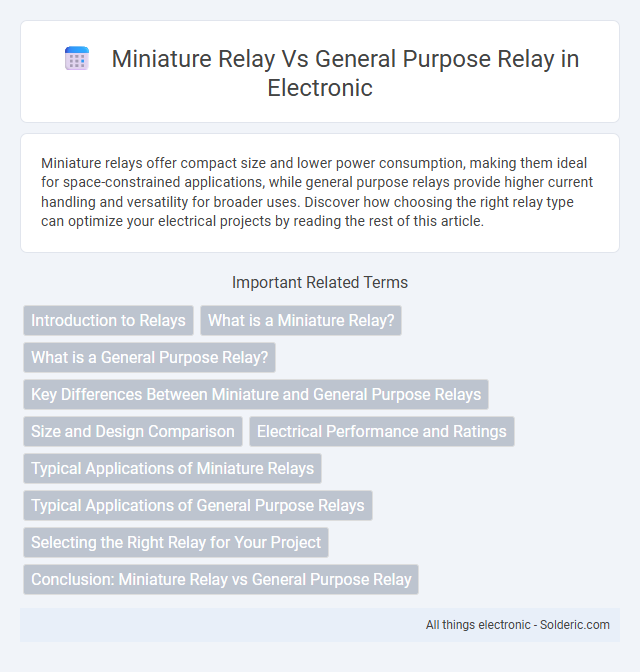Miniature relays offer compact size and lower power consumption, making them ideal for space-constrained applications, while general purpose relays provide higher current handling and versatility for broader uses. Discover how choosing the right relay type can optimize your electrical projects by reading the rest of this article.
Comparison Table
| Feature | Miniature Relay | General Purpose Relay |
|---|---|---|
| Size | Small, compact design | Larger, bulkier |
| Current Rating | Typically up to 10A | Can handle higher currents, often above 15A |
| Application | Used in compact circuits, PCB mounting | Suitable for industrial, heavier loads |
| Coil Voltage | Wide range, often low voltage (5V to 24V) | Varies widely, including higher voltages |
| Contact Configuration | Typically SPST, SPDT | Multiple configurations, SPST, SPDT, DPDT |
| Response Time | Faster switching | Slower switching compared to miniature types |
| Cost | Generally lower cost | Higher cost due to robustness |
Introduction to Relays
Miniature relays provide compact switching solutions with low coil power consumption, making them ideal for space-constrained applications and precise control tasks. General purpose relays feature higher current capacity and robust construction suitable for broader industrial and commercial uses requiring reliable switching of larger loads. Understanding your specific load requirements helps determine whether a miniature or general purpose relay best suits your control system.
What is a Miniature Relay?
A miniature relay is a compact electromagnetic switch designed for low-power control circuits, typically featuring a smaller size and lower coil power consumption compared to general purpose relays. It is ideal for applications requiring space-saving, fast switching, and high reliability in electronic devices such as telecommunications and automation systems. Miniature relays often support lower voltage and current ratings but provide precise control in densely packed electrical panels.
What is a General Purpose Relay?
A general purpose relay is an electromechanical switch designed to handle moderate current and voltage loads in various applications, such as industrial control systems and home appliances. Unlike miniature relays, general purpose relays often have larger physical sizes and higher power ratings, allowing them to manage more robust electrical circuits. Your choice between these relays depends on the required electrical specifications and space constraints of your project.
Key Differences Between Miniature and General Purpose Relays
Miniature relays are designed with compact size and lower power ratings, making them ideal for space-constrained applications and delicate electronic circuits. General purpose relays typically handle higher currents and voltages, offering more robust performance for industrial and heavy-duty uses. When selecting a relay for Your project, consider the load requirements and available space to determine if a miniature or general purpose relay best suits Your needs.
Size and Design Comparison
Miniature relays feature compact, lightweight designs ideal for space-constrained applications, whereas general purpose relays are larger with robust housings suited for higher power loads. Miniature relays often use surface mount or small pin configurations, optimizing circuit board real estate, while general purpose relays have bulkier terminals for easy manual wiring and durability. Your choice hinges on size constraints and specific application requirements, balancing compactness against mechanical robustness.
Electrical Performance and Ratings
Miniature relays typically feature lower coil power consumption, faster switching speeds, and ratings up to 10A at 250VAC, making them ideal for compact, low-power applications. General purpose relays offer higher current and voltage ratings, often supporting loads up to 30A and 277VAC, suitable for industrial and heavy-duty uses. Both relay types maintain similar dielectric strength and insulation resistance standards, ensuring reliable electrical performance across diverse operating environments.
Typical Applications of Miniature Relays
Miniature relays are commonly used in applications requiring compact size and precise control, such as telecommunications equipment, automotive electronics, and home appliances. Their small footprint and low power consumption make them ideal for circuit boards where space constraints are critical. Your projects involving signal switching or low-current applications can benefit from the high efficiency and reliability of miniature relays.
Typical Applications of General Purpose Relays
General purpose relays are commonly used in HVAC systems, automotive applications, and industrial machinery for switching moderate loads. They are ideal for controlling lighting circuits, motor starters, and other electrical devices requiring reliable on/off control. Your equipment benefits from their versatility and durability in a wide range of commercial and residential settings.
Selecting the Right Relay for Your Project
Choosing the right relay involves comparing miniature relays and general-purpose relays based on size, current rating, and application requirements. Miniature relays offer compact designs suitable for space-constrained projects, while general-purpose relays provide higher current and voltage handling ideal for industrial and heavy-duty applications. Evaluating factors like coil voltage, switching capacity, and environmental conditions ensures optimal relay performance and project reliability.
Conclusion: Miniature Relay vs General Purpose Relay
Miniature relays offer compact design and lower power consumption, making them ideal for applications with space constraints and precise control requirements. General purpose relays provide higher current and voltage handling capabilities, suitable for broader industrial and heavy-duty tasks. Selecting between the two depends on the specific electrical load, size limitations, and application needs.
miniature relay vs general purpose relay Infographic

 solderic.com
solderic.com